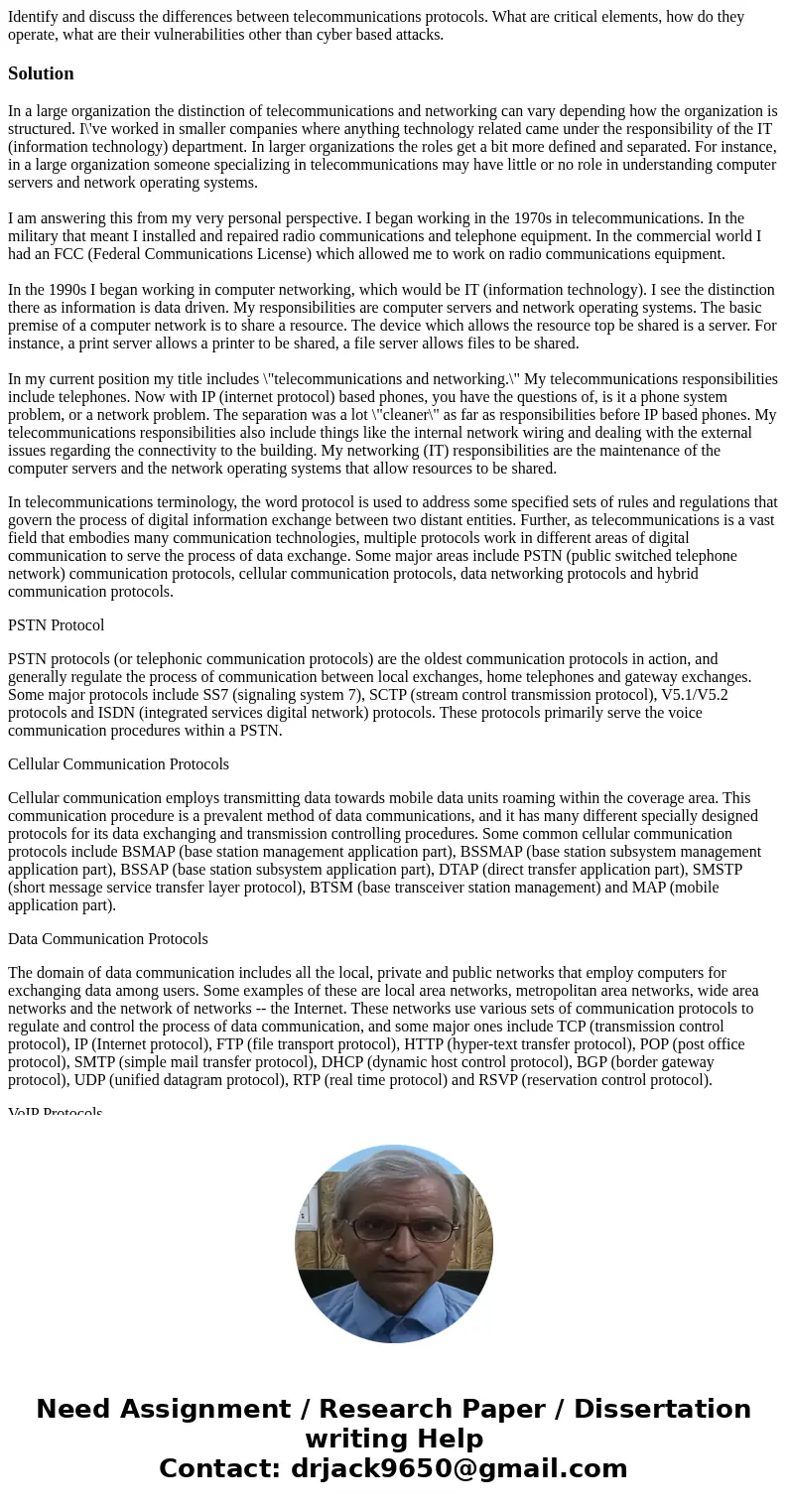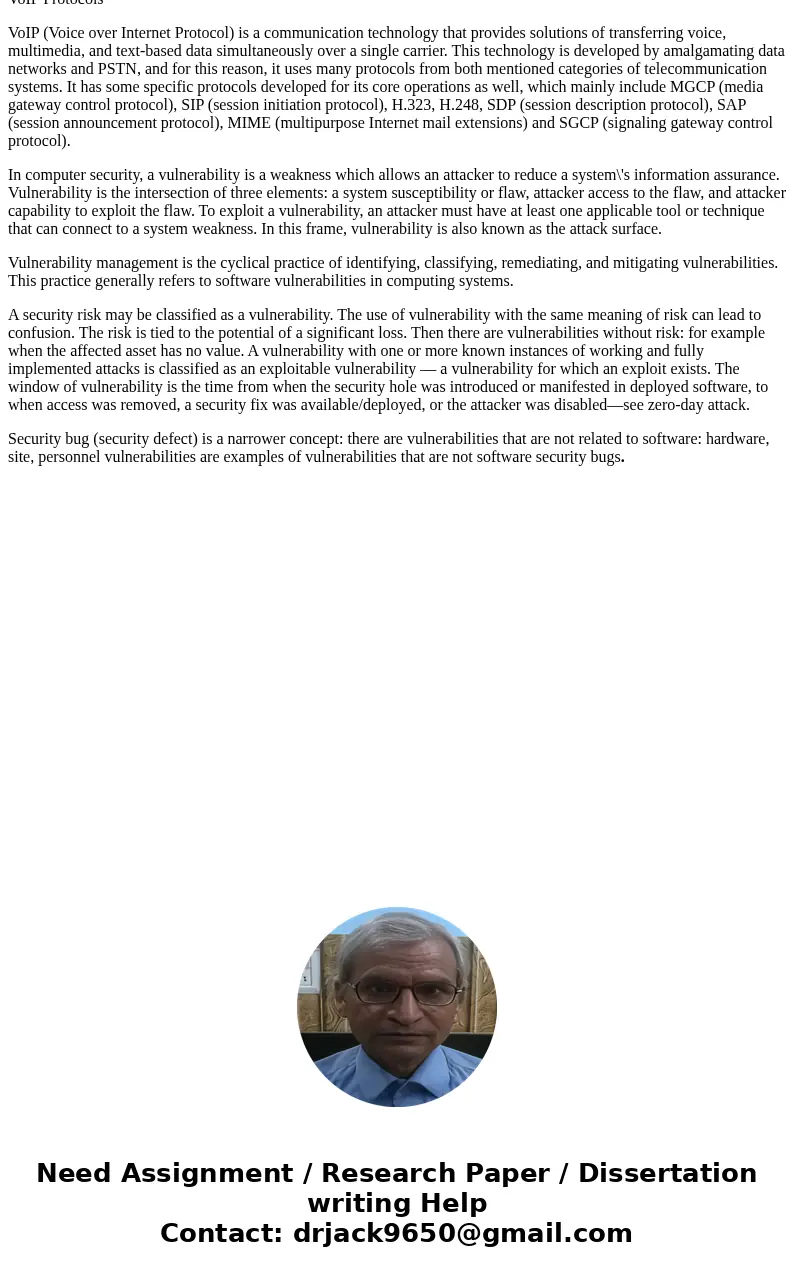Identify and discuss the differences between telecommunicati
Identify and discuss the differences between telecommunications protocols. What are critical elements, how do they operate, what are their vulnerabilities other than cyber based attacks.
Solution
In a large organization the distinction of telecommunications and networking can vary depending how the organization is structured. I\'ve worked in smaller companies where anything technology related came under the responsibility of the IT (information technology) department. In larger organizations the roles get a bit more defined and separated. For instance, in a large organization someone specializing in telecommunications may have little or no role in understanding computer servers and network operating systems.
I am answering this from my very personal perspective. I began working in the 1970s in telecommunications. In the military that meant I installed and repaired radio communications and telephone equipment. In the commercial world I had an FCC (Federal Communications License) which allowed me to work on radio communications equipment.
In the 1990s I began working in computer networking, which would be IT (information technology). I see the distinction there as information is data driven. My responsibilities are computer servers and network operating systems. The basic premise of a computer network is to share a resource. The device which allows the resource top be shared is a server. For instance, a print server allows a printer to be shared, a file server allows files to be shared.
In my current position my title includes \"telecommunications and networking.\" My telecommunications responsibilities include telephones. Now with IP (internet protocol) based phones, you have the questions of, is it a phone system problem, or a network problem. The separation was a lot \"cleaner\" as far as responsibilities before IP based phones. My telecommunications responsibilities also include things like the internal network wiring and dealing with the external issues regarding the connectivity to the building. My networking (IT) responsibilities are the maintenance of the computer servers and the network operating systems that allow resources to be shared.
In telecommunications terminology, the word protocol is used to address some specified sets of rules and regulations that govern the process of digital information exchange between two distant entities. Further, as telecommunications is a vast field that embodies many communication technologies, multiple protocols work in different areas of digital communication to serve the process of data exchange. Some major areas include PSTN (public switched telephone network) communication protocols, cellular communication protocols, data networking protocols and hybrid communication protocols.
PSTN Protocol
PSTN protocols (or telephonic communication protocols) are the oldest communication protocols in action, and generally regulate the process of communication between local exchanges, home telephones and gateway exchanges. Some major protocols include SS7 (signaling system 7), SCTP (stream control transmission protocol), V5.1/V5.2 protocols and ISDN (integrated services digital network) protocols. These protocols primarily serve the voice communication procedures within a PSTN.
Cellular Communication Protocols
Cellular communication employs transmitting data towards mobile data units roaming within the coverage area. This communication procedure is a prevalent method of data communications, and it has many different specially designed protocols for its data exchanging and transmission controlling procedures. Some common cellular communication protocols include BSMAP (base station management application part), BSSMAP (base station subsystem management application part), BSSAP (base station subsystem application part), DTAP (direct transfer application part), SMSTP (short message service transfer layer protocol), BTSM (base transceiver station management) and MAP (mobile application part).
Data Communication Protocols
The domain of data communication includes all the local, private and public networks that employ computers for exchanging data among users. Some examples of these are local area networks, metropolitan area networks, wide area networks and the network of networks -- the Internet. These networks use various sets of communication protocols to regulate and control the process of data communication, and some major ones include TCP (transmission control protocol), IP (Internet protocol), FTP (file transport protocol), HTTP (hyper-text transfer protocol), POP (post office protocol), SMTP (simple mail transfer protocol), DHCP (dynamic host control protocol), BGP (border gateway protocol), UDP (unified datagram protocol), RTP (real time protocol) and RSVP (reservation control protocol).
VoIP Protocols
VoIP (Voice over Internet Protocol) is a communication technology that provides solutions of transferring voice, multimedia, and text-based data simultaneously over a single carrier. This technology is developed by amalgamating data networks and PSTN, and for this reason, it uses many protocols from both mentioned categories of telecommunication systems. It has some specific protocols developed for its core operations as well, which mainly include MGCP (media gateway control protocol), SIP (session initiation protocol), H.323, H.248, SDP (session description protocol), SAP (session announcement protocol), MIME (multipurpose Internet mail extensions) and SGCP (signaling gateway control protocol).
In computer security, a vulnerability is a weakness which allows an attacker to reduce a system\'s information assurance. Vulnerability is the intersection of three elements: a system susceptibility or flaw, attacker access to the flaw, and attacker capability to exploit the flaw. To exploit a vulnerability, an attacker must have at least one applicable tool or technique that can connect to a system weakness. In this frame, vulnerability is also known as the attack surface.
Vulnerability management is the cyclical practice of identifying, classifying, remediating, and mitigating vulnerabilities. This practice generally refers to software vulnerabilities in computing systems.
A security risk may be classified as a vulnerability. The use of vulnerability with the same meaning of risk can lead to confusion. The risk is tied to the potential of a significant loss. Then there are vulnerabilities without risk: for example when the affected asset has no value. A vulnerability with one or more known instances of working and fully implemented attacks is classified as an exploitable vulnerability — a vulnerability for which an exploit exists. The window of vulnerability is the time from when the security hole was introduced or manifested in deployed software, to when access was removed, a security fix was available/deployed, or the attacker was disabled—see zero-day attack.
Security bug (security defect) is a narrower concept: there are vulnerabilities that are not related to software: hardware, site, personnel vulnerabilities are examples of vulnerabilities that are not software security bugs.


 Homework Sourse
Homework Sourse